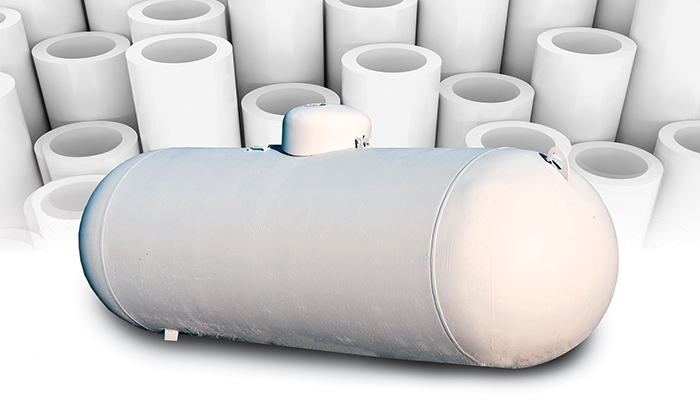All
Tank Installation: The Case for Polyethylene
by Donald Montroy, Bergquist Inc.

It’s fall again and that means football, apple cider, pumpkin pie, and new propane tank sets.
More than likely you have your tank set installation routine down pat. Btu load? Check. Properly sized regulators and pigtail? Check. Distance from tank to building? Check. Copper tubing and fittings? Check.
If you’re like many propane marketers across the country, I bet you’re using refrigeration copper for your lines, unless you run into rocky soil. Then, you may go to coated copper.
There is another, simpler, alternative to copper tubing, however: polyethylene (poly) tubing. It’s been used for new tank sets for decades now and has many advantages over copper tubing. A growing number of marketers consider poly tubing to be safer, easier to install, and less costly overall than copper tubing.
Some years ago, a propane marketer in Michigan received a phone call from a concerned customer that was suspicious of a gas leak. It was February, and Michigan had experienced an especially brutal winter. Upon inspection, the marketer noticed the poly tubing had completely pulled away from the service head of the flex riser. The reason was obvious. During installation, the poly tubing was not properly laid down in the trench. The solution is simple. Poly tubing should always be installed in a “snake-like” fashion to compensate for the freezing and thawing of soil, especially in colder, northern climates. The story is not intended to scare or deter marketers from choosing poly tubing for new tank sets. Just the contrary, properly installed poly tubing can be a safer alternative to copper tubing.
No Dielectric Fitting
Ease of repair is one safety advantage poly tubing possesses over copper. Snipping and removing a damaged section of poly tubing and repairing with a stab coupling is a snap. If the damaged section is long enough, a pair of couplings with a section of poly tubing in between (ranging in length from 8 to 24 inches) is available.
It’s important to be mindful of which brand of coupling is used for repair work. Most require the poly tubing to be properly chamfered before insertion into a stab coupling. Some brands are designed to chamfer the inside diameter of the poly tubing while others require the chamfer to be on the outside. All manufacturers provide proper chamfering directions and the correct chamfering tool for their products.
Newer code also requires cathodic protection in a propane system when using underground, metallic piping from tank to building. This is typically accomplished with a dielectric union on the second-stage regulator. With poly tubing, the code is a cinch. Poly tubing is plastic, and code only requires the dielectric component for metallic tubing, like copper. No dielectric fitting is necessary when using poly tubing on tank installations.
One of the chief complaints for using poly tubing, especially from industry veterans, is that it’s just so much easier to work with copper. Rolls of poly tubing tend to “spring out” when cutting the holding bands that keep it coiled. Copper is more malleable, so it stays nice and compact. That old argument is a tougher sell now that manufacturers strategically band poly tubing so that when the outside bands are cut, the rest of the roll stays intact. Still don’t like the idea of banded polyethylene tubing? Some manufacturers shrink-wrap their rolls to make it even easier to work with. Simply pull the tubing from the middle of the roll and it all stays tightly wound.
Equipment Requirements
Just as tank sets with copper tubing require equipment (dielectric fittings, flare nuts, unions) that are unnecessary when using poly tubing, some unique equipment is required with polyethylene installations. Flex risers are a necessary component for protecting poly tubing above grade. The advantage, however, is avoiding the clunky, sometimes imprecise step of flaring the tubing required for copper. A flush cut of the poly tubing, a solid push into the flex riser service head (already installed into the regulator), and tightening of the flex riser body into the service head is as simple as it gets.
Tracer wire or tracer tape is also necessary with poly tubing tank sets. The installation procedure is simple. Code requires the wire or tape to be a minimum of six inches above the poly tubing and a minimum of six inches below grade.
Perhaps the single biggest illustration of poly tubing’s ease of install is in applications when teeing off the main line toward an appliance that is separate from the building—a barn or pool heater, for example. Coupling manufacturers also produce stab tees to make such projects a breeze.
So what does all of this mean to your bottom line? It really depends on the price of copper. As copper prices decrease, it can be more cost effective to use on longer runs. As copper prices increase, poly tubing becomes more economical. With the volatility of copper prices over the past 10 years or so, the rule of thumb most industry professionals use is 30 feet. That is to say that runs less than 30 feet would use copper. Runs of 30 feet or more would utilize poly tubing. Of course this does not take into account the money thrown away along with the pieces of scrap copper after a job. In some areas of the country where the economy still hasn’t recovered from the last recession, copper theft is also an issue. This is especially true in areas with a greater number of vacation homes and rental properties.
The intention here is not to take away from the efficacy of copper tubing. It’s a tried-and-true method that’s been used for years. Some of the best service technicians in the country prefer copper tubing to poly tubing. But, for the various safety aspects, ease of installation, and cost savings provided, it’s time to give polyethylene tubing its due as the material of choice for new propane tank installations.
Related Posts
 National Energy Choice Legislation Advances Through Committee
National Energy Choice Legislation Advances Through Committee
Posted on November 20, 2025
 New and Improved: NEFI Member Benefits Deliver More Value
New and Improved: NEFI Member Benefits Deliver More Value
Posted on October 17, 2025
 It’s Upgrade Season. Get the Sale.
It’s Upgrade Season. Get the Sale.
Posted on October 16, 2025
 The Value of Providing Value
The Value of Providing Value
Posted on October 16, 2025
Enter your email to receive important news and article updates.
